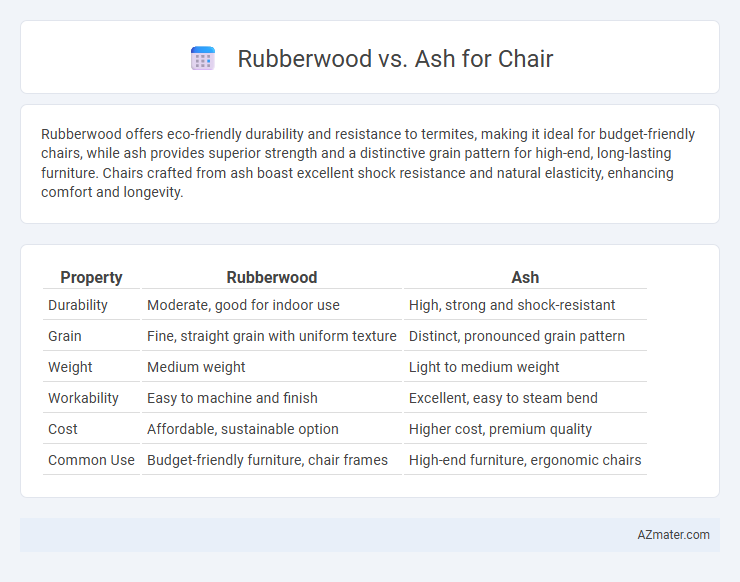Rubberwood offers eco-friendly durability and resistance to termites, making it ideal for budget-friendly chairs, while ash provides superior strength and a distinctive grain pattern for high-end, long-lasting furniture. Chairs crafted from ash boast excellent shock resistance and natural elasticity, enhancing comfort and longevity.
Table of Comparison
| Property | Rubberwood | Ash |
|---|---|---|
| Durability | Moderate, good for indoor use | High, strong and shock-resistant |
| Grain | Fine, straight grain with uniform texture | Distinct, pronounced grain pattern |
| Weight | Medium weight | Light to medium weight |
| Workability | Easy to machine and finish | Excellent, easy to steam bend |
| Cost | Affordable, sustainable option | Higher cost, premium quality |
| Common Use | Budget-friendly furniture, chair frames | High-end furniture, ergonomic chairs |
Introduction to Rubberwood and Ash
Rubberwood, derived from the Para rubber tree (Hevea brasiliensis), is prized for its sustainability and light color, making it ideal for contemporary chair designs that emphasize eco-friendliness and durability. Ash wood, known for its distinct grain patterns and exceptional strength, offers excellent shock resistance and flexibility, commonly used in traditional and modern chair manufacturing that requires robust structural integrity. Both woods present unique advantages in furniture making, with rubberwood favored for its cost-effectiveness and ease of finishing, while ash is valued for its hardness and long-lasting performance.
Key Characteristics of Rubberwood
Rubberwood is a sustainable hardwood known for its light color and fine, straight grain that provides a smooth finish ideal for chair making. Its medium density (approximately 560 kg/m3) offers durability and moderate strength, making it resistant to warping and cracking under typical household conditions. Rubberwood's natural resistance to insects and its eco-friendly sourcing from rubber plantations emphasize its appeal in environmentally conscious furniture production.
Essential Features of Ash Wood
Ash wood, known for its exceptional strength and elasticity, offers superior shock resistance ideal for chair construction. Its light to medium brown color with distinctive grain patterns provides both durability and aesthetic appeal, making it a favored choice for furniture requiring long-term resilience. The wood's workability allows for intricate designs while maintaining structural integrity, unlike rubberwood, which is softer and more susceptible to dents.
Durability Comparison: Rubberwood vs Ash
Rubberwood offers moderate durability with resistance to abrasion and moisture, making it suitable for lightweight chairs that endure regular use. Ash wood, known for its exceptional strength and shock resistance, provides superior durability ideal for heavy-use chairs needing long-term resilience. In terms of longevity and impact tolerance, ash outperforms rubberwood, making it the preferred choice for high-durability furniture applications.
Aesthetics and Finish: Rubberwood vs Ash
Rubberwood offers a light, uniform grain with a pale, creamy finish that lends a modern and clean aesthetic to chairs, making it ideal for minimalistic or Scandinavian-inspired designs. Ash features a prominent, open grain pattern with rich tones ranging from light beige to medium brown, providing a striking, natural appearance that enhances traditional and rustic chair styles. Both woods accept stains and finishes well, but ash's texture allows for more pronounced, tactile finishes, while rubberwood's smooth surface is better suited for glossy or painted coatings.
Sustainability and Environmental Impact
Rubberwood, sourced from retired rubber trees, offers a sustainable choice as it repurposes plantation timber otherwise discarded, reducing deforestation and waste. Ash wood, while durable and strong, comes from slower-growing hardwood species, making it less renewable and potentially contributing to habitat depletion when sourced unsustainably. Choosing rubberwood chairs supports eco-friendly forestry practices with lower carbon footprints compared to ash, aligning with green furniture demands.
Weight and Ease of Handling
Rubberwood is significantly lighter than ash, making chairs crafted from it easier to handle and move around. Ash, known for its density and strength, results in heavier chairs that provide more durability but can be cumbersome in comparison. The lightweight nature of rubberwood offers ergonomic benefits, especially for furniture requiring frequent repositioning.
Cost and Availability
Rubberwood is significantly more affordable than ash, making it a cost-effective choice for chair manufacturing due to its status as a byproduct of the latex industry. Availability of rubberwood is high in Southeast Asia, particularly Malaysia and Thailand, where sustainable plantation practices ensure a steady supply. Ash, while prized for its durability and attractive grain, is generally more expensive and less readily available outside North America and parts of Europe, impacting its cost and procurement for chair production.
Best Uses for Rubberwood and Ash in Chairs
Rubberwood excels in chair manufacturing due to its durability, affordability, and resistance to warping, making it ideal for casual and indoor seating such as dining and lounge chairs. Ash wood offers superior strength and a distinctive grain pattern, making it the preferred choice for high-end, ergonomic, and sculptural chair designs that require shock resistance and aesthetic appeal. Both woods provide excellent workability, but Rubberwood's sustainable sourcing and Ash's long-lasting hardness optimize their respective uses in different chair styles and environments.
Final Verdict: Which is Better for Your Chair?
Rubberwood offers affordability, sustainability, and a light, uniform grain that suits modern chair designs, while ash boasts superior hardness, durability, and a striking grain pattern ideal for high-traffic use. Choosing ash ensures longevity and robust performance in heavy-duty seating, whereas rubberwood provides an eco-friendly option with decent strength and ease of finishing. For a chair requiring both resilience and aesthetic appeal, ash is typically the better choice, but rubberwood excels in budget-conscious and environmentally focused projects.

Infographic: Rubberwood vs Ash for Chair
 azmater.com
azmater.com